Table of Contents.
Tram
Accident in
Gothenburg, 1992.
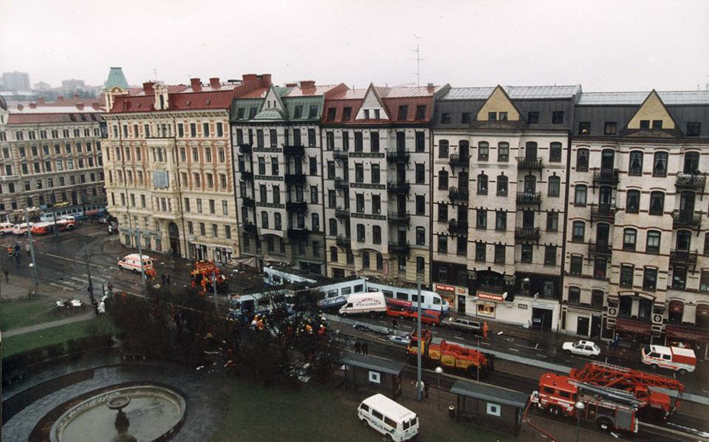
Vasaplatsen in
Gothenburg. The tram at line
7 has crashed
at the tram stop.
On March 12, 1992, at 9:17 p.m., the tram at line 7
derailed at Vasaplatsen in Gothenburg. The tram
came at high speed towards the tram stop. Many of those waiting at the
stop were matchless when the tram crashed into
them. 13 people were killed and 29 were injured
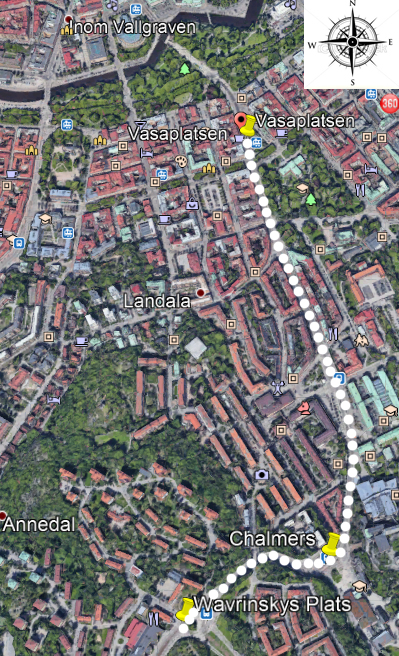
The tram's disastrous journey from Wavrinskys Plats
to Vasaplatsen.
The tram, of type M21, was heading in a southerly direction when it
suddenly became powerless at Wavrinskys Plats.
The cause was reported to be a contact wire failure. The track was
powerless from Wavrinskys Plats and on in a southerly direction towards
Södra Guldheden. The contact wire was intact from
a point about 25 meters behind the tram and on
towards Vasaplatsen. A traffic controller had
begun the work on redirecting two other
trams that were on the route behind the powerless tram.
He was in contact with the traffic management via
a communication radio.
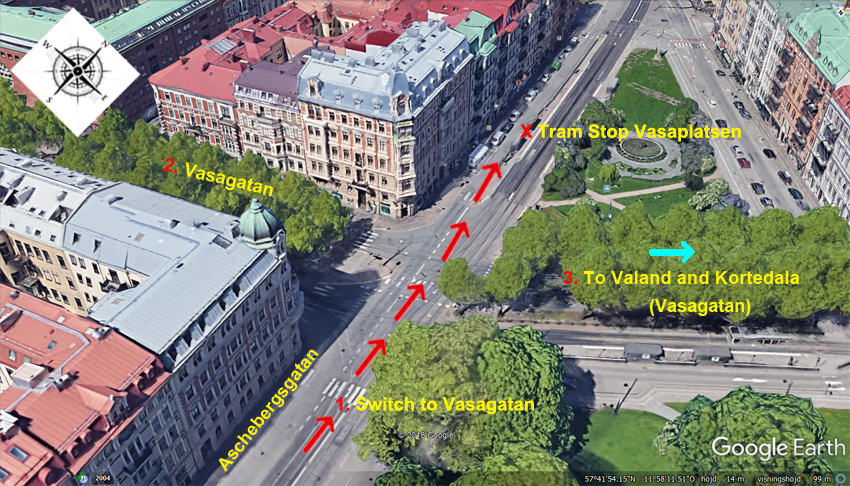
Overview in a northerly direction to (X)
Tram
Stop Vasaplatsen.
(1.) The
switch to Vasagatan
was a so-called. backup switch. The traffic
controller ordered the trams that stood behind the powerless tram to
back down towards the switch and on towards (2.)
Vasagatan. Then they
could continue forward (3.)
To
Valand and Kortedala.
The red arrows show the path of the tram.
The traffic controller had now arrived at the powerless tram at
Wavrinskys Plats. The driver had previously
ordered the passengers to disembark. The traffic controller saw that the
tram was on a slope towards Vasaplatsen. He decided that it should be
rolled back, about 25 meters, to enter under
powered contact wire. To make this possible, he
disconnected
the tram's mechanical braking system. It had been automatically switched
on when the tram
became powerless.
.Knowledge of the tram's different braking systems is required for
the continuation:
Electrodynamic brake.
The tram's electric motors provide braking power as the driver reduces
the power supply to the motors. The braking power is
highest when the speed is high.
This brake has no effect in a powerless tram.
Mechanical brake.
This brake is described in a sketch from the accident report (see
below).
Magnetic
rail brake.
The function is based on the fact that brake shoes when braking are
pulled to the rails by electromagnetic force and that the friction
between brake shoes and rails gives a supplementary braking force to
other braking systems. This brake has no effect in a powerless tram.
Emergency brake.
The driver can achieve maximum braking effect in an emergency
situation by
activating all the braking systems.
When a passenger pulls an emergency brake
handle, the mechanical brake is
activated.
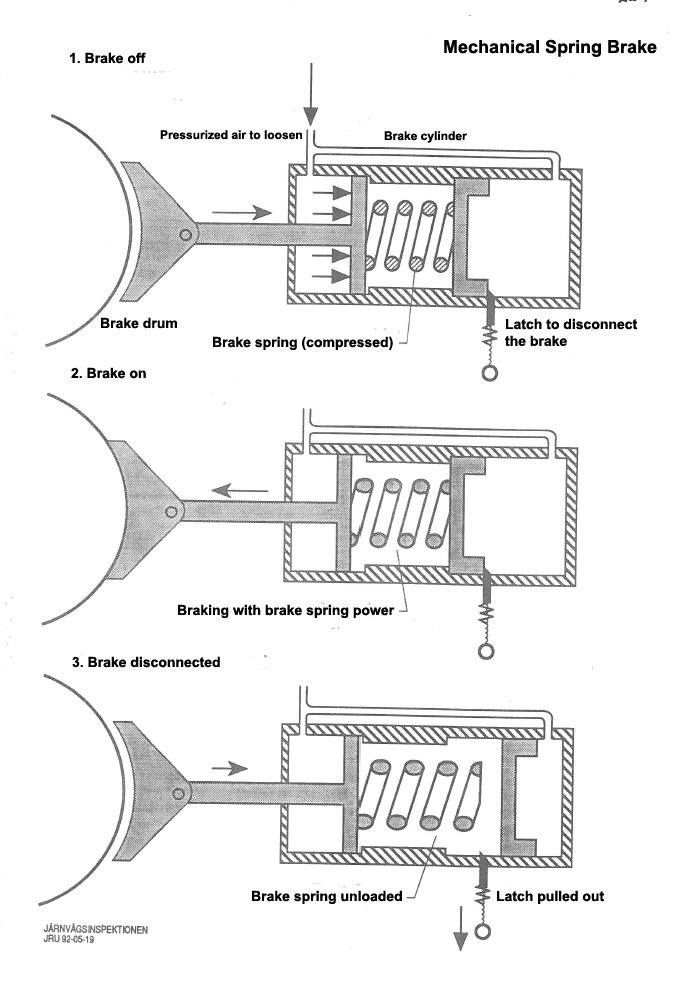
The above sketch shows the function of the tram's mechanical braking
system. To
disconnect the brake on a wheel, there was a handle attached to
a
wire on the outside of the tram. When pulling the
handle, a latch was released which
disconnected the brake. The traffic
controller conducted disconnecting on six pairs of wheels, i.e. a total of
12 wheels. Disconnecting the mechanical brake in this way from a
powerless tram was a violation of the regulations. To restore the brake,
supply of compressed air was required. Compressed air could not be
produced when the tram was powerless.
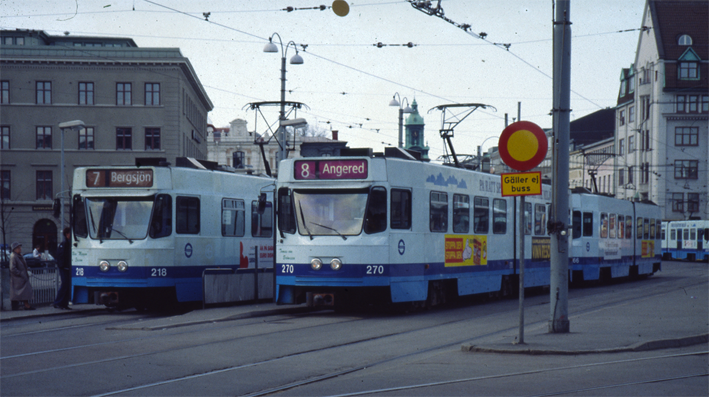
Trams of the
type M21. On the roofs of the
trams the pantographs are
visible.
While the traffic controller disconnected the mechanical brakes, the
driver fixed the tram's pantographs. They were operated using
compressed air. They had gone down when the power failure occurred. The
driver mechanically hoisted the pantographs
by pulling a wire.
The traffic controller ordered the driver to take a seat in the
car
at the back of the train. There
was a space used when
driving the tram
backwards. That
car would now be at the front in the
direction of travel as the tram was reversed. The driver was instructed
by the traffic controller to pull in an emergency brake handle when the
tram entered
under the
powered contact
wire. The purpose was to
stop the
tram and activate all important functions once the power was
in place.
Electric compressors would be started to produce the
compressed air required to restore the mechanical brakes to
the normal. When
the tram was under
powered contact
wire, the driver pulled the emergency brake.
He got no braking
effect. He
then pulled two other emergency brake handles - without getting any braking
effect. The tram now rolled
uncontrollably. The driver moved to the driver's seat in the
car
which was now at the
far
back of the
travelling direction. There he tried to activate the
tram's electrical system. It failed. The distance between
Wavrinskys Plats and Vasaplatsen is about 1,4 km. The fall height is
about 47 m. When the tram approached the switch to Vasagatan the speed
was about 100 km / h. There was no way for the tram to
switch
towards Vasagatan at this high speed. It
derailed and continued
straight ahead to the
tram stop at Vasaplatsen. The distance from the
switch to the
tram stop is about 80 m. Of course, the speed slowed somewhat
when the tram rolled on the street, but it was still high when it first
crashed against the
tram stop and then against a house wall. The tram collided with 12 cars during
its journey towards
Vasaplatsen. The driver of the tram cope with only minor injuries.
This CIA-led operation is V-marked. It is well planned. My suspicion is
that a number of key people have been included in the planning. The
power
failure at Wavrinskys Plats was no accident. Someone
in a central location in the traffic management has
turned off the power when the tram
had arrived at Wavrinskys Plats.
This place was the optimal starting point for the
operation. The track slopes along the entire route from Wavrinskys Plats to Vasaplatsen. The
target was the people who were
at the
tram stop at Vasaplatsen.
Derailing would certainly take place
at the switch to Vasagatan. My assumption is that the traffic controller
has not been included in the conspiracy. He has been familiar with the
regulations regarding the mechanical brakes of the tram. He has been
ordered from the traffic management to release the mechanical
brakes to roll the tram
under the power
wire. When the driver pulled the
emergency brake, it had no effect because the mechanical brakes were
disconnected. When he tried to activate the electrical system it had no
effect as the contact
wire was powerless on the entire route
down to Vasaplatsen.
Judicial aftermath.
Two years after the crash, the CEO of
the Gothenburg's
Tramways and the
traffic
controller was indicted. The crime classification was grossly
abusive until the death of another and
dangerous carelessness
to the public. The traffic
controller was convicted on all counts and sentenced to conditional
sentence. The CEO was acquitted.
Here you can download the accident report:
Rapport_J_1992-1
(4,25 MB, all in Swedish)
A memorial to honour the victims of the disaster
is installed
at Vasaplatsen.